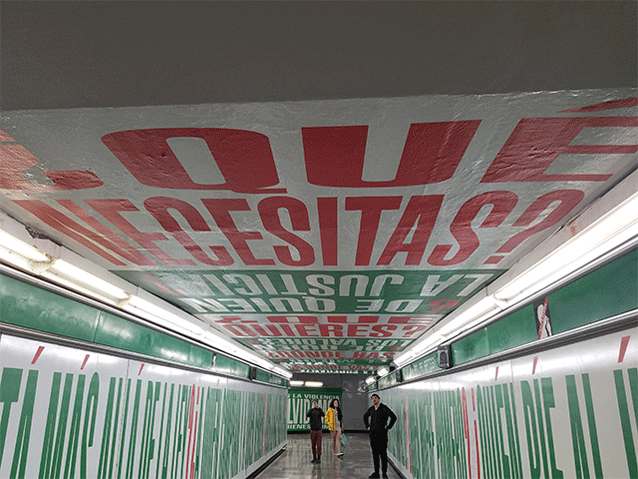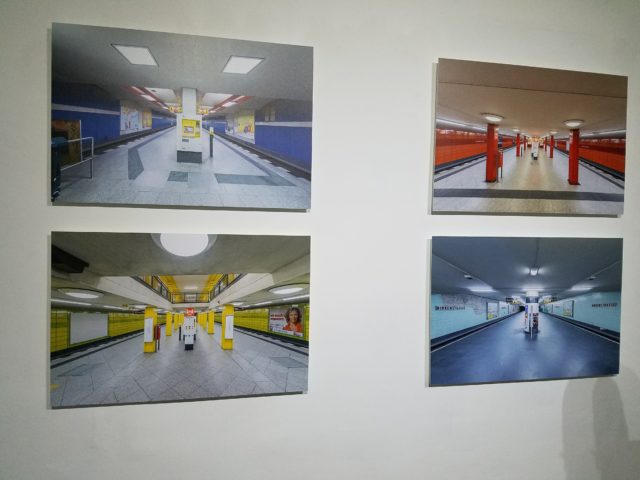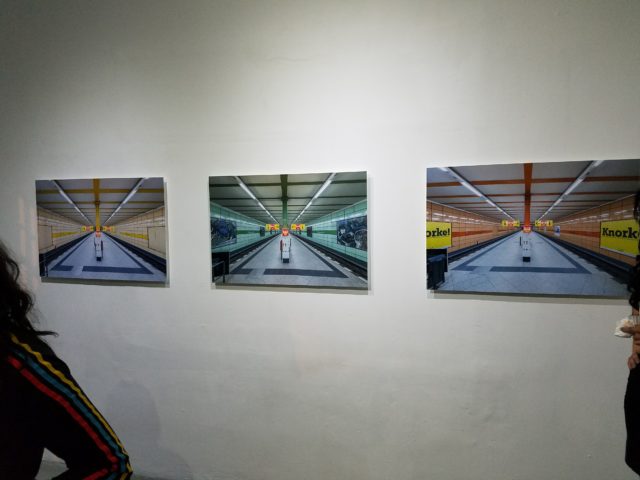Barbara Kruger: Empatía
Bellas Artes Metro Station
Angela Peralta, Colonia Centro, Ciudad de México, D.F.
What’s on View: Giant blocks of white, green, and red text, oriented in different directions. Each has a different question or declarative platitude such as “WHO SACRIFICES HONOR FOR MORE TIME?”, “WHO HAS THE LAST LAUGH?” or “ENOUGH SHOULD BE SUFFICIENT”. The vinyl signage is installed in a narrow transfer tunnel between two metro lines in a busy station below the national art museums.
Michael: I know these GIFs are dizzying, but I’m including them because they give a pretty accurate sense of what viewing this piece is like IRL. If anything, the text is more legible in photographs. There are a few design issues here that give the impression this piece was planned without a good grasp of the site. For starters, I had been in this metro station several times before I actually encountered the piece. It’s installed in a one-way transfer tunnel that one would only use if changing trains from the 8 to the 2. We arrived via the 2, and I think we actually had to disobey signage to enter the installation from the opposite direction of foot traffic? It’s therefore unlikely that most people would even be able to read the text pointing in the opposite direction.
On top of that, most of the text is squeezed into an aspect ratio that makes it extremely hard to read in a small, crowded space. At first, I thought this might be a “Spanish-as-a-second-language” issue for us, but our Mexican friends seemed even less impressed. The color choice (the Mexican flag) kinda made it feel like Christmas advertising and it seemed like most people were breezing by without paying attention. It seems like it’s not a very effective piece of public art, if for no reason other than the fact that it requires a lot of logistical effort on the part of passers-by to maneuver their bodies against the flow of traffic in a crowded but out-of-the-way space to actually read the text.

Molly: The GIFS are dizzying but accurately reproduce my experience descending into the Barbara Kruger tunnel. At first I thought the text was purposefully illegible, like a magic eye trick I should try to decrypt, but upon further investigation I think it was just poor planning. The ceiling work was the most effective part of the installation for me because it transported me out of the space and seemed slightly more readable. Trying to view the installation made me feel guilty I was intruding on people’s paths as they were trying to go about their day. I also haven’t been able to make a connection between Kruger’s use of Mexico’s national colors and the text besides the fact that the installation is *in Mexico.* Kruger doesn’t paste stars and stripes on the wall when she installs in the United States so I don’t know understand why she thought it necessary here. The hallway gave me more of a feeling that I was at the north pole than any sense of nationalism.
Michael: Exactly! I liked the ceiling too, which had sequential panels in one direction reading:
WHAT DO YOU WANT?
WHAT DO YOU NEED?
WHERE HAVE YOU BEEN?
WHERE ARE YOU GOING?
Leading to a larger statement on the wall “IN VIOLENCE WE FORGET WHO WE ARE”

It was one of the few areas where the text seemed to have a logical relationship with the space. I also really liked “BLIND IDEALISM IS REACTIONARY SCARY MORTAL.” I read that as very timely, as she installed the work shortly after Trump was elected, when the Left was in full-on finger-pointing/name-calling mode. It helped that this text wasn’t squished, and was positioned in a place where it was clearly legible as you descended the stairs from the “correct” side of the tunnel.
This leads me to believe the work in general would be more effective in a larger space, such as the mezzanine levels or platforms themselves, where people are already standing still and can have a bit of distance rather than being rushed and smushed against the text.
Juan Pablo de la Vega: Untergrund Metro

Celaya Brothers Gallery
Mérida 241, Colonia Roma Norte, Ciudad de México, D.F.
On view in D.F. until Jan. 25th, 2017. On view at Laboratorio Oaxaca February 3-5
What’s on View: Presented as part of a year-long cultural exchange between Germany and Mexico, nearly-symmetrical photos of different train platforms from the Berlin U-Bahn. Each station has been photographed when completely empty of both trains and humans.
Michael: I really love each of these photos, but as an exhibition I found myself wanting more. Perhaps it’s an issue of scale? I think I might’ve liked these more had they been printed larger, but the problem could also lie in the fact that a room-full of nearly-identical photos of empty train stations can only do so much. Individually, most of the images are gorgeous. Collectively, they make me appreciate the impulse to archive. The series feels almost more like a documentary endeavor than a “fine art” gesture. I’m curious about your thoughts, Molly, because I’m a total urban planning/public transit nerd so of course I was engaged.
Molly: One of my first thoughts entering the show was “I bet Michael loved these photos.” I know how passionate you are about urban planning. I don’t usually think about metro stations beyond being a means to an end. I appreciate that these photos forced me to treat spaces, which I usually regard solely transitory, as fixed destinations. I had a lot of the same criticisms you did initially, but as I spent more time in the space the collection of images began to feel like a visual diary and I enjoyed that intimate feel.

Michael: Yeah! I became weirdly more curious about these images maybe because of the scarcity of information in them. I started playing a game where I guessed which stations were from the East and which ones were from the West. I am pretty sure the ones with two rows of columns on the platform are from the sole subway line the Soviets built under Karl Marx Allee and the ones with a single column are from the much larger U-Bahn network that the West controlled.
I am a nerd.



Comments on this entry are closed.